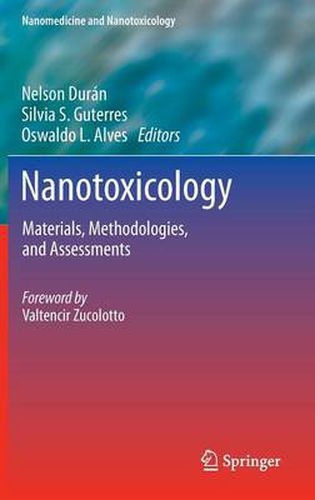Readings Newsletter
Become a Readings Member to make your shopping experience even easier.
Sign in or sign up for free!
You’re not far away from qualifying for FREE standard shipping within Australia
You’ve qualified for FREE standard shipping within Australia
The cart is loading…






This title is printed to order. This book may have been self-published. If so, we cannot guarantee the quality of the content. In the main most books will have gone through the editing process however some may not. We therefore suggest that you be aware of this before ordering this book. If in doubt check either the author or publisher’s details as we are unable to accept any returns unless they are faulty. Please contact us if you have any questions.
This book takes a systematic approach to nanotoxicology and the developing risk factors associated with nanosized particles during manufacture and use of nanotechnology. Beginning with a detailed introduction to engineered nanostructures, the first part of the book presents concepts and definitions of nanomaterials from quantum dots to graphene to fullerenes, with detailed discussion of functionalization, stability, and medical and biological applications. The second part critically examines methodologies used to assess cytotoxicity and genotoxicity. Coverage includes interactions with blood (erythrocytes), combinatorial and microarray techniques, cellular mechanisms, and ecotoxicology assessments. Part three describes cases studies both in vitro and in vivo for specific nanomaterials including solid lipid nanoparticles and nanostructured lipid carriers and metallic nanoparticles and metallic oxides. New information is also presented on toxicological aspects of poloxamers and polymeric nanoparticles as drug carriers as well as size effects on cytotoxicity and genotoxicity. Didactic aspects are emphasized in all chapters, making the book suitable for a broad audience ranging from advanced undergraduate and graduate students to researchers in academia and industry. In all, Nanotoxicology: Materials, Methodologies, and Assessments will provide comprehensive insight into biological and environmental interactions with nanostructures.
Provides an introduction to nanostructures actually in use
Describes cyto- and genotoxicity methodologies, and assesses their performance in comparison to common toxicity assays
Discusses the relation of cytotoxicity and genotoxicity to ecotoxicity
Presents a range of applications, from biogenic silver nanoparticles to poloxamers as drug-delivery systems, reflecting the expanding applications of nanotechnology
$9.00 standard shipping within Australia
FREE standard shipping within Australia for orders over $100.00
Express & International shipping calculated at checkout
This title is printed to order. This book may have been self-published. If so, we cannot guarantee the quality of the content. In the main most books will have gone through the editing process however some may not. We therefore suggest that you be aware of this before ordering this book. If in doubt check either the author or publisher’s details as we are unable to accept any returns unless they are faulty. Please contact us if you have any questions.
This book takes a systematic approach to nanotoxicology and the developing risk factors associated with nanosized particles during manufacture and use of nanotechnology. Beginning with a detailed introduction to engineered nanostructures, the first part of the book presents concepts and definitions of nanomaterials from quantum dots to graphene to fullerenes, with detailed discussion of functionalization, stability, and medical and biological applications. The second part critically examines methodologies used to assess cytotoxicity and genotoxicity. Coverage includes interactions with blood (erythrocytes), combinatorial and microarray techniques, cellular mechanisms, and ecotoxicology assessments. Part three describes cases studies both in vitro and in vivo for specific nanomaterials including solid lipid nanoparticles and nanostructured lipid carriers and metallic nanoparticles and metallic oxides. New information is also presented on toxicological aspects of poloxamers and polymeric nanoparticles as drug carriers as well as size effects on cytotoxicity and genotoxicity. Didactic aspects are emphasized in all chapters, making the book suitable for a broad audience ranging from advanced undergraduate and graduate students to researchers in academia and industry. In all, Nanotoxicology: Materials, Methodologies, and Assessments will provide comprehensive insight into biological and environmental interactions with nanostructures.
Provides an introduction to nanostructures actually in use
Describes cyto- and genotoxicity methodologies, and assesses their performance in comparison to common toxicity assays
Discusses the relation of cytotoxicity and genotoxicity to ecotoxicity
Presents a range of applications, from biogenic silver nanoparticles to poloxamers as drug-delivery systems, reflecting the expanding applications of nanotechnology